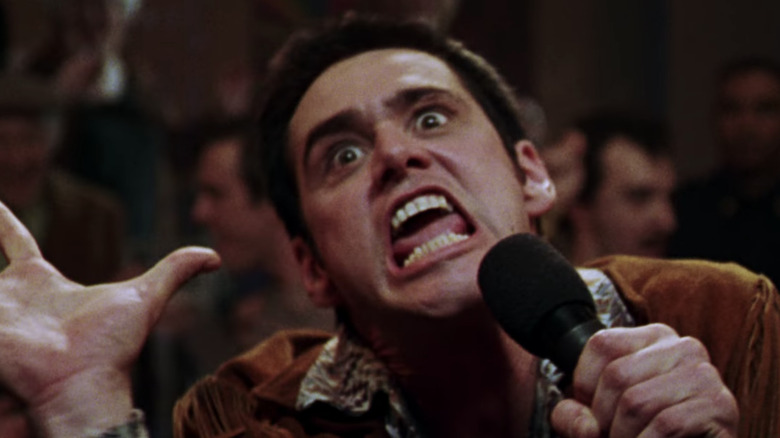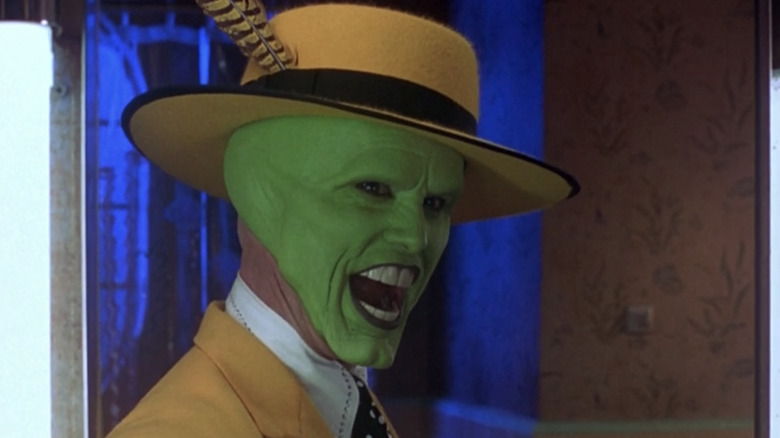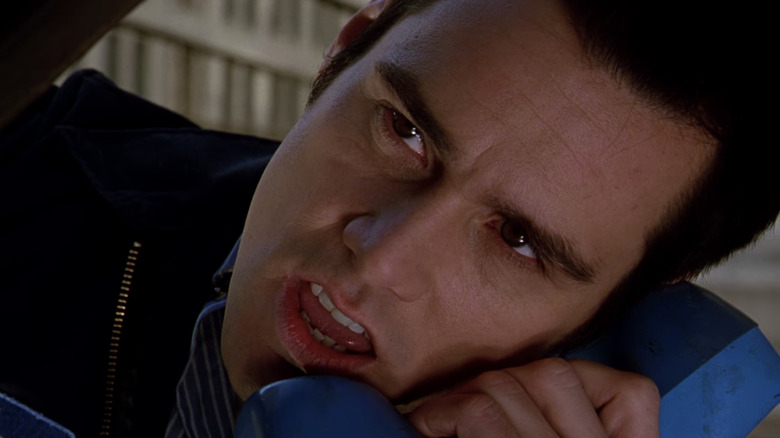The Jim Carrey Role That Changed Hollywood Forever
While you were watching Super Bowl LVI, you may have been treated to a Verizon commercial featuring Jim Carrey, reprising his role from the 1996 Ben Stiller-directed black comedy "The Cable Guy." If you weren't preoccupied with your chips and dip or going to the bathroom, that is. Considering that film's mediocre critical reception and middling box office performance, there were probably some of you watching it and thinking, "Oh, yeah. I kind of remember this." With the incessant use of famous faces and intellectual property in commercials now, they were bound to dredge up this character from a movie with a cult following to sell some tech stuff. Jim Carrey wanted to make some quick cash, and he probably got paid a decent amount for it, but it certainly won't hold a candle to his payday for the actual film.
You see, "The Cable Guy" might be this interesting curio of the 1990s now, but at the time of its release, it was a major watershed moment in how movies got made. Specifically, it showed the absolute excess of the era with how movie stars were being rewarded financially. Jim Carrey in "The Cable Guy" was the first actor to receive a whopping $20 million for his performance. Keep in mind, "The Cable Guy" only had a budget of $47 million. Carrey's salary alone took up almost half of that. This was the price of a gigantic movie star at the time, and it's tough to remember just how monumental Carrey's stardom was, considering the paltry state of movie stars today. To understand how he could get to this point, we need to look back a couple of years earlier.
Nobody had a better 1994 than Jim Carrey
In the 1980s, Jim Carrey was a working stand-up comic who occasionally got small parts in movies such as "Peggy Sue Got Married" and "Earth Girls Are Easy." But in 1990, Carrey began starring in the sketch show "In Living Color," where he made quite a splash with his over-the-top energy and ability to contort his face and body into anything to sell a joke. Production company Morgan Creek Entertainment, a 1990s staple of producing movies with moderate budgets, put their weight behind Carrey, giving him his first leading role in a film, "Ace Ventura: Pet Detective." He was paid a healthy $450,000 for the film, which he also co-wrote. "Ace Ventura" went on to make over $100 million at the worldwide box office after it came out February 4, 1994, showing there was quite a lot of excitement around seeing Jim Carrey on the big screen.
His next film, "The Mask," came out on July 29, 1994. As his deal for this film was made before the release of "Ace Ventura," he was paid a similar figure, which was still a respectable number. "The Mask" was an even bigger hit, raking in over $350 million. Carrey's star power was undeniable at that point. "Dumb and Dumber," his third film that year which was released December 16, 1994, was made just after "Ace Ventura" hit theaters, so his salary demands increased exponentially. Carrey managed to earn a $7 million payday for the Farrelly Brothers' comedy. He was a minted, bonafide superstar when "Dumb and Dumber" came out, and domestically, it was the biggest hit of the three. Then, he followed those up the next year with the colossal hit that was "Batman Forever." You have a string of hits like that, and you can ask for the world.
It took just a year for Jim Carrey to go from funny TV guy to blockbuster A-lister. When he signed up to do "The Cable Guy," the only trajectory he had known was up, so grabbing that $20 million certainly seemed like plausible compensation. Once that barrier was broken, all the other A-listers wanted to rise up and grab that same check or even more. Julia Roberts was the first woman to earn $20 million for her Oscar-winning performance in "Erin Brockovich." Arnold Schwarzenegger raked in a whopping $25 million to play Mr. Freeze in "Batman and Robin." If you were a big star at this time, you were making some serious bread.
The future of the back end
Along with that $20 million salary, Jim Carrey received 15% of the film's profits on the backend, making him even more money. Points on the backend have regularly been the way big-name talent made a ton of money. Usually, they forego some of their traditional salary, if not all of it, in order to allot the money to other areas of the production budget. They will instead take that percentage, and if the film is a big hit, they stand to make way more money than they would have simply with a normal salary.
Carrey is also a perfect example of this strategy with his 2008 film "Yes Man." While a basically forgotten picture at this point, "Yes Man" was actually quite a big hit back when it was released, grossing over $220 million worldwide. Carrey opted to not receive any salary for the film, instead negotiating for a massive 36.2% on the backend. After the gross covered its production and marketing budgets, Carrey earned approximately $30 million for the film. Perhaps more.
Because points have been such a reliable method for so many actors on earning their paydays, salaries have been able to drop for big names over the years. What is already starting to complicate this method tremendously is the rise of streaming. We have already seen this with the lawsuit from Scarlett Johansson filed against Disney for putting "Black Widow" on Disney+ day and date, cutting into her contractually agreed upon backend points. Profit-sharing for streaming is such a murky issue, as there isn't an a la carte payment system for movies on these services. What percentage of a subscription price should these people get? While this gets figured out, we may be seeing a shift back to that old model, paying big salaries upfront. It really seems to be the only way for big-name talent to continue making the money they have been making as the industry basically shifts entirely to a streaming model. It would not surprise me to see a lot more Jim Carrey in "The Cable Guy" salaries in the near future.


